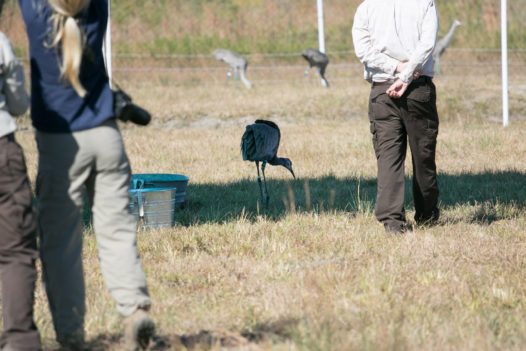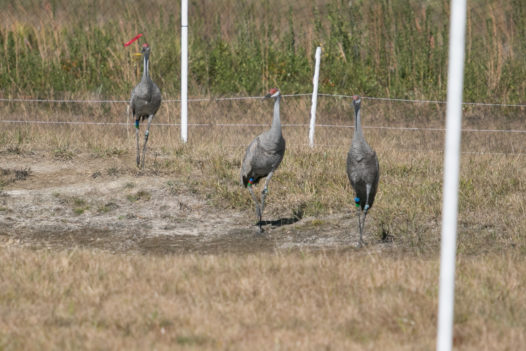
Photos provided by: Audubon Nature Institute
(Gautier, MS.) – Audubon Nature Institute animal care professionals traveled to Mississippi on Thursday, December 1 and added another happy ending to the latest chapter in a decades-long quest to save an endangered species.
As if on cue, four Mississippi sandhill crane chicks raised at Audubon Nature Institute’s Freeport-McMoRan Audubon Species Survival Center (FMASSC) slowly walked out of a protective pen as young adults, spread their wings and soared off into into the clear, blue skies above the Mississippi Sandhill Crane National Wildlife Refuge in Gautier, Mississippi.
The unique conservation program has resulted in a stabilized population of a critically endangered species that was on the brink of extinction 20 years ago when Audubon partnered with the refuge in an attempt to halt the decline.
There were smiles all around on Thursday as the four cranes looked down on their new home where they now will have to fend for themselves and, with a bit of luck, give rise to another generation of cranes, this time born in the wild.
The release this week culminated more than six months of intense, hands-on monitoring by Audubon staff following the birth of the four chicks at the Species Survival Center on New Orleans’ West Bank back in April and their transfer on Nov. 1 to the Mississippi refuge where they lived inside a pen enclosed in netting.
The successful release was the product of a labor of love, said Michelle Hatwood, curator at FMASSC.
“This is why we work hard every single day,” said Hatwood. “To see an animal that would have gone extinct 30 years ago still fighting to survive makes every minute of work worth it.
“Audubon’s ability to have such a large effect on a conservation project so close to home is an inspiration for communities to care about the natural world around them. Nature is not a faraway place. It’s in our backyard and we are responsible for that.”
A lighthearted Audubon tradition to name cranes hatched at the center based on a theme continued this year. In 2016, the choice was games and the roster included one male, Solitaire, and three females: Connect, Taboo and Scrabble.
Seeing the four cranes readily adapt to their natural environment was an emotional moment for Scott Hereford, U.S. Fish and Wildlife Service Senior Wildlife Biologist at the Mississippi Sandhill Crane National Wildlife Refuge.
“It’s hard to put into words what it fet like when we watched those four birds take off,” Hereford said. “Even now, thinking about it, I’ve got goosebumps. It was just incredibly dramatic and uplifting to see them fly free on their own on this refuge that was set aside for them. Really, it’s the high point of the year.”
Going forward, refuge staffers will track and study the cranes’ movement with the help of tiny radio transmitters.
“Eventually, they’re going to do what they’re supposed to do – they’re going to nest and add to the population,” Hereford said. “It’s an incredibly fulfilling day today. And I’m so happy to be a part of it. It’s wonderful.”

Photos provided by: Audubon Nature Institute
History of Audubon’s Mississippi Sandhill Crane Program
Since the partnership began in 1995, Audubon has released more than 200 birds into the Mississippi refuge. Today, about 65 percent of the crane population was hatched and raised at Audubon.Almost all the chicks were hand-raised by keepers and volunteers in costume. Being a crane “mom” is hot and demanding work. The heavy costume is necessary to keep chicks from associating humans with food.
This season’s chicks were raised via two different methods. Two were costume-reared and two were raised by parent cranes.
Currently, the refuge population hovers between 120 and 130 birds. The goal is to create a self-sustaining environment in the wild that is no longer reliant on captive breeding.
Fewer than 35 of the cranes existed in 1975 when the U.S. Fish and Wildlife Service established the 19,300-acre refuge in Mississippi, the first ever created under the Endangered Species Act of 1973.
While the cranes’ original range followed the wet pine savanna habitat across the southern Gulf Coast, from Louisiana to the Florida panhandle, the cranes nearly became extinct because of land development, pine plantations and invasive plant species.
 NOLAbeings Multimedia artist Claire Bangser created NOLAbeings as a portrait-based story project that marries...
NOLAbeings Multimedia artist Claire Bangser created NOLAbeings as a portrait-based story project that marries...  Voodoo in New Orleans: Reviving history: New Orleans fortune telling This article takes a deep dive into the history of Voodoo in New Orleans, its hybridization with Catholicism, and its present-day place in the city's culture. The author visits fortune-tellers in the French Quarter, using their guidance as a tool for introspection rather than a deterministic predictor of the future. Through her experiences in New Orleans, the author feels a mystical connection to both the past and the future.
Voodoo in New Orleans: Reviving history: New Orleans fortune telling This article takes a deep dive into the history of Voodoo in New Orleans, its hybridization with Catholicism, and its present-day place in the city's culture. The author visits fortune-tellers in the French Quarter, using their guidance as a tool for introspection rather than a deterministic predictor of the future. Through her experiences in New Orleans, the author feels a mystical connection to both the past and the future. 